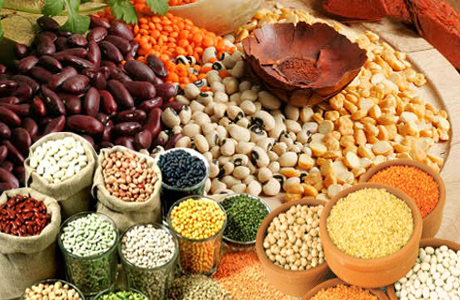Pulses output down, imports
up
By Mohiuddin Aazim
 The
import of pulses is soaring due to a decline in domestic
output for lack of serious efforts for sustainable growth in
production.
The
import of pulses is soaring due to a decline in domestic
output for lack of serious efforts for sustainable growth in
production.
Pulses are unable to
compete with the preferred cultivation of major crops that
offer relatively better returns.
Imports shot up by 43pc to
308,000 tonnes during July-December 2014, from 215,000
tonnes in July-December 2013.
While the domestic output fluctuated from year to year, the
overall pulses’ imports fell from 672,000 tonnes in FY12 to
473,000 tonnes in FY13 owing to large domestic production of
major pulses crop — black gram and chickpeas.
But in FY14, imports rose
again to 506,000 tonnes because of a slump in production of
all kinds of pulses.
Officials of the Ministry of National Food Security and
Research say that black gram and chickpeas claim the biggest
share in overall output of pulses, followed by Moong, Mash
and Masoor.
Pakistan produces below one
million tonnes of all pulses that are cultivated on less
than 5pc of the country’s cropped area.
The production of black gram and chickpeas fell by 37pc from
751,000 tonnes in FY13 to 475,000 tonnes in FY14, while the
output of Moong, Mash and Masoor remained almost unchanged
at 110,000 tonnes.
That is why FY15 began with
higher imports of pulses, officials explain.
But they expect that pulses’ production in FY15 to be higher
than in FY14 and the imports in FY16 should decline.
The Federal Committee on Agriculture had set FY15’s
production target of 720,000 tonnes for black gram and
chickpeas. Officials say reports from fields suggest that
the actual output would show no big slippage.
In the absence of a realistic price discovery system, big
growers don’t take the risk of cultivating pulses as their
main source of earnings. They routinely go for major crops.
If the target is met, the
aggregate output of all pulses should range between
850,000-870,000 tonnes because combined production of three
other main pulses would be around 130,000-150,000 tonnes.
But even in that case, a
little quantity of Masoor and Mash will have to be imported
because, according to field reports, production of these two
pulses will fall short of domestic requirements.
Pulses’ production remain
erratic primarily because crops of leguminous vegetables (or
pulses) are grown over marginal lands attached to main
farmland and around key crops’ farms.
Besides, in the absence of a realistic price discovery
system, big growers don’t take risk of cultivating pulses as
their main source of earnings. They routinely go for major
crops.
But the biggest obstacle in raising output is research on
how per-hectare yield can be increased and how high-yielding
varieties can be strengthened and protected against diseases
and pest attacks.
Between 2003 and 2009, Pakistan Agriculture Research Council
had released for commercial cultivation, 22 new varieties of
chickpeas, Moong Mash and Masoor.
That has helped in boosting
pulses’ output to some extent. But the problem is that
introduction of new or better varieties is not enough.
Farmers also need government support in sticking to PARC-recommended
standards for quality variety cultivation..
This gap is being filled by the Punjab government under a
Rs150m plan to boost output of Masoor, Gram and Mash
launched in July 2014. Selected growers in all districts of
the province have been encouraged to cultivate pulses.
Officials of agricultural
extension department say most of those farmers have
harvested their crops with higher per-hectare yields.
But the crops of some farmers
were fully or partially damaged by last year’s heavy rains
and floods or due to pest attack.
“Once analysis of the data on
crop size, per-hectare yield and maturity period is
completed, we’ll guide farmers on what methods, used in
harvesting, has to be replicated”, an official involved in
the project told Dawn over telephone.
One perennial impediment to promoting production of pulses
is unavailability of certified seeds. Officials say that
less than 5pc of the required seeds for pulses comes from
formal sector and the remaining 95pc comes from informal
sources.
That is why, ensuring
continuous cultivation of high-quality pulses’ varieties
becomes difficult and, even those varieties evolved through
long and arduous research lose strength after some years.
Traditionally, farmers keep a part of their harvested grains
of pulses for using as seeds for the next crop.
The seed stocks sometimes
lose their hygienic strength and there is no scientifically
tested storage facility, the PARC officials say.
This practice is more damaging in case of newly-developed
high-yield varieties that give promised yield only if the
seeds’ productivity strength doesn’t get compromised and
only if the seeds are cultivated under the soil conditions
similar to those wherein they were initially evolved.
February 2015
Source: Dawn
News